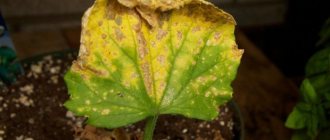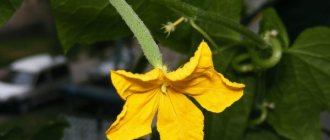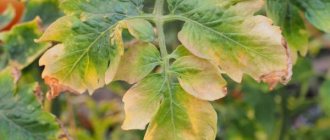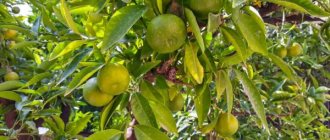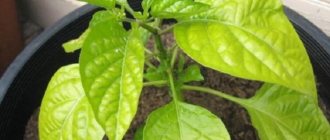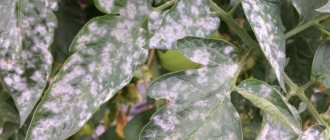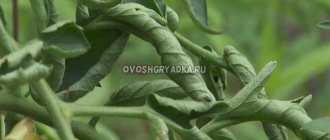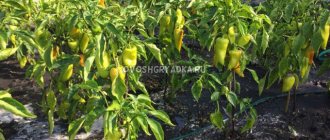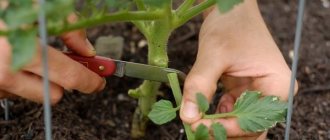Main reasons
The most common reasons are obvious and banal: lack of sun, water or nutrients. Such problems are quite easy to correct, and the seedlings will return to normal on their own. But at the same time, yellowness can be an alarming symptom of various diseases or fungus. More radical action is needed here.
Sometimes yellowing is a natural process that indicates the plant’s adaptation to the conditions around it. It may indicate problems with the absorption and transfer of minerals. In any case, it is better to wait a couple of days first - perhaps the problem will disappear on its own. The main thing is to make sure there are no other symptoms!
Fusarium infection
The affected plant can infect neighboring bushes
Tomato leaves begin to lighten, then turn yellow, dry out and fall off the stem. First, the lower specimens are affected, then fusarium moves upward. Unfortunately, it is pointless to treat the disease with folk remedies; do not waste time, because an infected tomato under the influence of fusarium not only dies itself, but also takes its neighbors with it.
Help for tomatoes
The gardener has two options. You can pull out all infected tomatoes, or you can treat them with fungicides. Or rather, these substances only inhibit the development of viral bacteria, giving the plant the opportunity to fight the disease itself.
Prevention
It is known that it is easier to prevent a disease than to fight it. What are the preventive measures to prevent tomato leaves from drying out and turning yellow?
Plants are usually infected with fusarium blight in July. High air temperatures and excessive humidity levels are ideal for the growth of bacteria. From the moment you plant the seeds in the soil, you should protect your future harvest. Start by disinfecting the seeds, soil and containers, because disinfection makes it more difficult for bacteria to survive. At the first stage (a month before planting), use potassium permanganate, then, after two weeks, use phytosporin. Already on the 15th day after planting, regularly treat tomatoes with biofungicides. Also, to protect tomatoes from bacteria, do not plant too densely, get rid of the lower leaves in time and avoid too much watering. Such simple measures will significantly reduce the risk of developing fusarium in your seedlings.
The lower leaves of tomatoes turn yellow
For adult plants, yellowness from below is a normal biological course of events, because they develop and age. Tomatoes shed “ballast” to concentrate resources on the development of young shoots and fruit formation. If there are no other symptoms and you are in good condition, you do not need to do anything.
Sometimes the lower leaves wither immediately after transplantation - this is a natural reaction of sprouts to stress. You need to keep the top healthy, and the seedlings can handle the rest on their own. When the leaves below finally die off, just remove them as soon as possible so as not to create favorable conditions for diseases.
Rules of care: advice from experienced gardeners
The good condition of tomatoes depends on following the rules of caring for them.
Experienced vegetable growers advise adhering to the following technology for growing tomatoes in a greenhouse and open ground:
- Watering 1-2 times a week with warm, settled water. The soil is soaked deeply. Frequent, scanty watering leads to the movement of roots into the upper layers of the soil, where they overheat and begin to dry out.
- Installation of supports for high grades. Growing without tying is permissible only for low-growing, determinate (self-forming) tomatoes.
- Bush formation. For low-growing varieties, it is enough to free them from excess leaves at the base of the stem to increase air circulation and prevent fungal diseases. Medium and tall plants require regular pinching. Tomatoes are formed into 1-2 stems, removing all excess shoots that form from the bottom. When grown in greenhouses, approximately 3rd part of the leaves is cut off from bushes of any variety.
- Proper, regular feeding. For tomatoes, it is important not only the timely application of nutrients to the soil, but also the composition of fertilizer mixtures. During the growth of green mass, the main nutrient is nitrogen. From the beginning of the formation of buds and during the formation of fruits, nitrogen in fertilizers should contain a minimum amount. During this period, tomatoes are fed with phosphorus-potassium mixtures.
- Preventive treatment against fungal and bacterial diseases. The most common diseases of tomatoes are late blight and anthracnose (fusarium wilt). The spores of these fungi infect plants in unfavorable conditions and are transmitted through water and soil. Copper-containing drugs help prevent infection: HOM, Oxychom, Forecast.
The top leaves of tomatoes turn yellow
When the young shoots on top turn yellow first, they lack nutrients. Useful minerals simply do not reach them, so it’s time to fertilize or spray.
— If yellow spots appear along the veins or in the middle of the plates, there is little iron. After feeding with 1% chelate or vitriol, the problem will disappear in a couple of days. Do not just use salts, because they interfere with the absorption of phosphorus;
— With calcium deficiency, the leaves begin to change from the very tips. The second indirect sign is if the flowers begin to fly around. And when the tomatoes already bear fruit, dark spots appear on them, which quickly increase;
— When the bases of the leaves become deformed, and not the edges as usual, and then change color, a weak solution of boric acid is needed. A lack of boron in the future may lead to the death of the ovaries and a deterioration in the taste of the crop;
— Red veins on yellow plates and weak woody shoots are symptoms of sulfur deficiency. In this case, magnesium sulfate is best;
— Uneven spots along the plates that turn pale and give off a yellowish tint are a reason to treat them with potassium permanganate. It is also a good antiseptic that prevents the development of fungal diseases. Vary the concentration from 1 to 3 g, depending on the intensity of the problem.
Malnutrition
Conscientious owners, fearing that their vegetables will be overloaded with chemicals, use exclusively organic fertilizers, such as rotted manure, to feed them.
The need for fertilizing
Whatever one may say, to get a large amount of harvest you will have to fertilize with microelements such as calcium, magnesium, boron. Nothing bad will happen if you follow the recommended doses and replenish after rain and watering.
It is not difficult to recognize a nutrient deficiency in a plant: the leaves on the tomatoes turn yellow, red, and dry. Then the phenomenon gradually affects the entire area, the foliage changes color, dries out and crumbles.
Tomato leaves turn yellow and curl
Deformation and yellowing of leaves is a dangerous sign and usually indicates more serious problems. At best, this is uneven growth due to lack of lighting or a serious shortage of fertilizers. But often the reason is that mites or aphids are hiding on the back of the plates. In the worst case, the parasites eat the roots.
What to do if the edges of tomato leaves turn yellow
If the tomato leaves begin to turn yellow around the edges, this is a signal to the gardener that the crop is experiencing a shortage of certain substances:
- Nitrogen . The leaves turn yellow and burn at the edges and soon fall off. Plants weaken and begin to wither. Nitrogen fertilizing will help improve the health of the bush. Urea can be used as a fertilizer (1 tbsp per 10 liters of water).
- Potassium . Young leaves are deformed and curled into a tube, old leaves turn yellow at the edges. Such plants are indicated for treatment with potassium nitrate. For 10 liters of water you will need 1 tbsp. l. drug.
Related article:
Tomato foliage - to remove or not? All about pinching vegetables
Tomato leaves turn yellow and wither
Yellowness and wilting of the leaves most likely indicate an excess of moisture at the same time as low temperature. Reduce watering, use warm water and build a shelter. Check the feeding schedule to see if the seedlings have enough nitrogen and other nutrients. Make sure that the wilting begins gradually and from the edges, otherwise it is a likely symptom of fungus.
Soil acidification
This problem is primarily indicated by a yellowish or white coating on the surface of the earth. This is due to the high severity of irrigation water. It must be settled and boiled. This is the only way to get rid of chlorine and other impurities.
It is not difficult to help the problem. For this:
- remove the top soil by about 1 centimeter;
- the vacated space is filled with fresh soil;
- watering is carried out exclusively with prepared water;
- The bush is not given any mineral fertilizer for 15 days.
Tomato leaves turn yellow after planting
Planting is always stressful for seedlings, and it affects their well-being and appearance. Adaptation is a normal feature of the life cycle, not limited to plants. But if the situation does not stabilize on its own in the near future, the reasons may lie deeper.
— A fungus or larvae of pests could remain in the soil, which now eat the young seedlings;
— When replanting, it is especially easy to damage the delicate root system. If the damage is minor, the plants will return to normal on their own;
— Sprouts react most quickly to improper watering, so monitor the moisture level of the substrate;
- If it turns out that it is still too cold outside, the tender young foliage of the seedlings will turn yellow. Wait for stable warming, because the rush to replant can cause damage to the crop. It could even be June in the northern regions.
Moisture deficiency
Gradual wilting of the foliage, loss of elasticity, curling and peeling mean that the tomato is not receiving enough moisture. The farmer is to blame for this. Here are a number of possible causes of the disaster:
- the central root touched during planting in the ground, after which it usually begins to build up the surface layer;
- frequent watering of young animals with a small amount of liquid / irregular watering system.
A touched or damaged root is most often unable to obtain water for the plant. Therefore, it should be handled with care.
Irrigation system
As for frequent watering, it is also important to know when to stop. Tomatoes must be able to provide themselves with moisture, otherwise they will climb to the very surface. If you suddenly stop watering the leaves, they will turn yellow and dry out. Therefore, you will have to not change the system and continue to pamper your tomatoes until the end of the season / growing season.
Tomato leaves turn yellow in open ground
Seedlings in an open area are much more exposed to any external influences. These are winds, rains, scorching sun, insects and pests - which means it is important to quickly determine the source of the problem.
— During drought and heat, the leaves of tomatoes dry out from lack of moisture, so increase the frequency of watering;
— If it’s cold outside and it’s been raining for a long time, there’s probably too much moisture, so come up with a shelter;
— Tomatoes often turn yellow due to unexpected frosts, because this is their natural reaction to hypothermia;
— The leaves will turn yellow if the rhizome is accidentally damaged during excavation work. The plant then focuses on recovery and sends fewer nutrients to the above-ground part. This is a normal process, so just watch;
— When there is not enough nitrogen and potassium in the soil, the leaves grow weaker, become smaller, become deformed and turn yellow. This is a sure signal to carry out unscheduled feeding;
— Tomatoes get sick, like any other plants. Late blight or mosaic stains are usually irregular, haphazard and chaotic. They spread rapidly, change color and texture, and can swell or dry out. Not all diseases can be treated, and damaged bushes must be isolated immediately without waiting for them to spread.
Errors during cultivation
Have your tomato leaves dried out?
It happened, it didn't happen
When growing tomatoes, inexperienced vegetable growers make typical mistakes that lead to improper plant development, drying of leaves, damage to roots and reduced yields:
- Lack of seedling hardening . 2 weeks before planting tomatoes in open ground or a greenhouse, it is necessary to begin to accustom the plants to new conditions. For this purpose, seedlings are organized for “walks” in the fresh air. Starting from 30-40 minutes and gradually increasing the time. Unhardened seedlings experience severe stress when planted and begin to get sick. More details in our other article: How to grow tomato seedlings at home
- Wrong choice of soil composition . Tomatoes do not tolerate acidic soil, so when choosing a site for growing them, it is necessary to stabilize the pH level to 6-6.5. Adding a small amount of wood ash to the holes or liming the soil in autumn helps neutralize excess acidity.
- Planting seedlings too early . Moving tomato roots into unheated soil. Tomatoes can only be planted in soil whose temperature has reached plus 15 degrees at a depth of 15-20 cm. Planting in cold soil causes illness and even death of tomato seedlings.
- Thickened plantings . The distance between tomato bushes should be at least 50 cm. The desire to plant the maximum number of plants in a small area leads to disruption of the nutrition of the roots and ventilation of the above-ground part. Thickened plantings are a direct path to disease and low yields.
- Planting in the shade . Tomatoes need maximum light throughout the day. Even light shading of bushes leads to increased bushiness of plants to the detriment of yield.
- Excess fertilizer . Tomato feeding should be balanced in three elements: nitrogen, phosphorus, potassium. Exceeding the nitrogen content in the soil leads to fattening of the bush. As a result, the vegetable grower receives a densely leafy bush with a powerful stem without flowers or ovaries. Frequent feeding with fresh manure is especially destructive for tomatoes. For fertilizer, it is advisable to choose specialized mixtures with a calculated amount of nutrients, and prepare a solution from them in strict accordance with the recommendations on the packaging. The interval between fertilizing is 15-20 days.
Expert opinion
Yulia Safronenko
Big fan of experiments and personal gardening techniques
Ask a Question
Yellowing and drying of leaves on tomato bushes is a signal from the plant about its own troubles. This phenomenon requires immediate action on the part of the vegetable grower, otherwise you may never get tasty and healthy fruits.
Tomato leaves turn yellow in a greenhouse
It seems that in the greenhouse there are absolutely ideal conditions for tomato seedlings to feel good. However, plants are living organisms, so there is no universal panacea for all ills.
— If the leaves of tomatoes not only turn yellow, but also rot, then the humidity in the greenhouse is too high. Lower it to about 65% and make sure it doesn't get cold. Be sure to install and monitor thermometers and sensors;
— Too infrequent and too frequent watering is equally destructive for seedlings. If the yellow leaves dry out, they don’t have enough moisture, and if they soften, you need to dry the soil and reduce watering;
— During intensive growth of green mass, always use nitrogen. Apply it little by little, but in several passes, so as not to burn the roots and spoil the soil. Leaves that have enough strength and minerals will quickly restore color. We recommend combining nitrogen with ash - it is rich in potassium and prevents acidification;
— If everything is in order with the care, but the leaves of the tomatoes still turn yellow, the root system may be damaged. These are not necessarily pests: maybe someone accidentally damaged the root with a shovel. If the problem is purely mechanical, the plants will recover on their own when they gain strength again;
— In diseases, other symptoms also appear: yellow spots turn into dark ones, and the plates and shoots become bent. The development of viruses is aggravated by heat, excess nitrogen and moisture, and improper planting.
Damage to the root system of tomatoes
One of the main reasons for yellowing of leaves is disturbances in the root system. Damage may occur if care is not taken when planting seedlings or removing weeds with strong roots. Deep loosening of the soil can also damage the root system of plants.
The main sign that the problem is caused by damage to the root system is that the lower leaves begin to turn yellow. After some time, they will begin to crumble, exposing the central trunk. The reason for the massive shedding of leaves is that the roots cannot provide the plant with oxygen and nutrients.
To restore the balance between the root system and the above-ground part, it is recommended to resort to fertilizing. A plant provided with the necessary elements will quickly produce young roots and devote all its energy to growing green mass. It would be useful to carry out several hillings, which stimulate the formation of roots from the central trunk.
Illumination
If yellowing appears on the tomatoes, then the plants may not have enough sun. Most often, such bushes have weak foliage on the opposite side and an elongated stem. Balcony varieties and seedlings suffer from a lack of ultraviolet radiation.
To correct the situation, you need to provide the vegetables with proper lighting. After the seeds have hatched, it is better to illuminate the seedlings with a phytolamp. If the crop has yellow leaves, then it is worth moving it to a more suitable windowsill. We recommend choosing indoor hybrids that are resistant to light deficiency.
